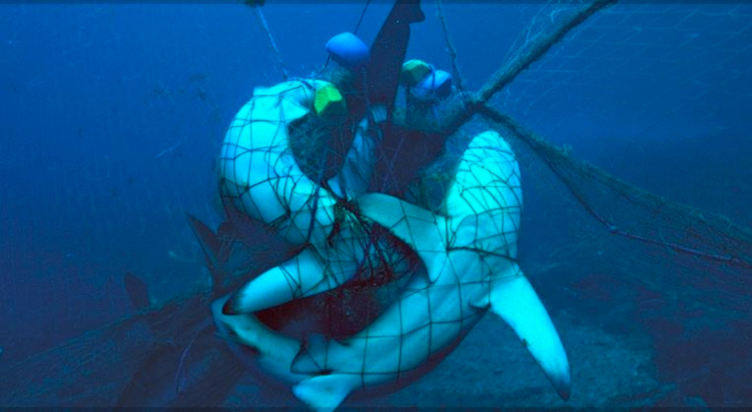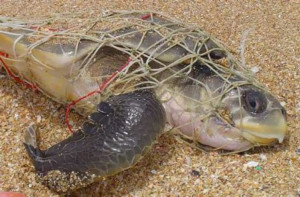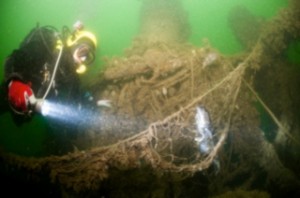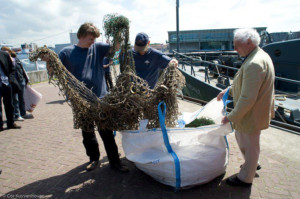Marine Life & Conservation
Ghost Fishing

In a way the term Ghost Fishing almost has a sci-fi/adventure feel to it and does little to portray the great horror and devastation it actually inflicts on the marine environment around the world. The first I ever new about Ghost Fishing was back in the 1980’s when I joined the Sea Shepherd Conservation Society to make a film for UK television about the Drift Net fisheries in the North Pacific for Tuna and salmon. At that time, the combined Japanese and Taiwanese fishing fleets were laying approximately 20,000 miles of drift net at any one time. Each net being up to 30 miles long and 100 feet deep, drifting on the ocean currents catching everything that came in their path.
As well as the targeted catch of Tuna, the bi-catch was of unimaginable quantities. Everything perished – Whales, Dolphins, Turtles, Seals, Sea Birds, Sharks and many species of pelagic fish.
Many of these nets were lost at sea and continue to ‘fish’ until the shear weight of the catch would drag them to the sea bed. But this was not the end of the nets’ fishing life. On the sea bottom the nets continue to entangle marine life until one day the ‘catch’ would decompose enough to allow the nets to once again rise to the surface and begin the whole process over again.
Those nets are still out there. It is not just mono-filament nets that cause ‘Ghost Fishing’ problems. Any lost or discarded fishing tackle will take its toll. The problem continues.
There is a Dutch group who are trying to tackle the problem. The article below is written by Pascal van Erp, one of the directors of www.ghostfishing.org
Ghost Fishing is what fishing gear does when it has been lost, dumped or abandoned. Imagine a fishing net that gets snagged on a reef or a wreck and gets detached from the fishing vessel. Nets, long lines, fish traps or any man made contraptions designed to catch fish or marine organisms are considered capable of ghost fishing when unattended, and without anyone profiting from the catches, they are affecting already depleted commercial fish stocks. Caught fish die and in turn attract scavengers which will get caught in that same net, thus creating a vicious circle.
Ghost nets are among the greatest killers in our oceans, and not only because of their numbers. Literally hundreds of kilometers of nets get lost every year and due to the nature of the materials used to produce these nets, they can and will keep fishing for multiple decades, possibly even for several centuries.
When caught on a reef, nets do not only catch fish, turtles, crustaceans, birds or marine mammals, they also destroy hard and soft corals, wiping out complete ecosystems while swaying in the current. If caught on wrecks nets can suffocate a wreck and thereby render hiding places for marine life useless, or even trap them inside.
 Divers are all too familiar with this phenomenon, especially in well fished areas. The founders of Ghost Fishing were confronted with ghost nets while diving the many wrecks in the Dutch North Sea. In 2009 they joined a local team of divers who started to clean those wrecks. After some years of local efforts it was time to broaden the horizon and get in touch with like-minded groups all over the world. And so the Ghost Fishing foundation was born. As of March 2013, Ghost Fishing is collaborating with 14 teams worldwide to work on existing projects, set-up new ones and document these through visual media, educating divers, informing a wide audience and raising social awareness. The Foundation exchanges solutions and best practices and maintains a steady stream of information through social media, and a website that offers extensive information and possibilities for interaction.
Divers are all too familiar with this phenomenon, especially in well fished areas. The founders of Ghost Fishing were confronted with ghost nets while diving the many wrecks in the Dutch North Sea. In 2009 they joined a local team of divers who started to clean those wrecks. After some years of local efforts it was time to broaden the horizon and get in touch with like-minded groups all over the world. And so the Ghost Fishing foundation was born. As of March 2013, Ghost Fishing is collaborating with 14 teams worldwide to work on existing projects, set-up new ones and document these through visual media, educating divers, informing a wide audience and raising social awareness. The Foundation exchanges solutions and best practices and maintains a steady stream of information through social media, and a website that offers extensive information and possibilities for interaction.
Collecting ghost nets is also part of a broader mission in which The Foundation works towards sustainable recycling of the nets, which will be used as raw material for new products.
The Ghost Fishing Foundation was started as a non-profit organization in November 2012 and has already presented itself at the Hylkesukelus 2013, a wreck diving seminar in Helsinki, Finland and Duikvaker 2013 in the Netherlands where the message was well received and many valuable contacts were made. The next event will be Baltictech Conference 2013 in Poland where the most recent material of our work will be shown.
In 2013 we hope to participate in clean-up work in Krnica, Croatia, Portofino, Italy and if funding permits more plans will be set-up and executed.
As marine debris is rapidly becoming a greater problem, it is imperative to take real action as soon as possible. Ghost Fishing intends to collect funds to finance clean-ups, to sponsor gear, to train divers and to raise public awareness.
If you would like to know more or start your own project visit http://www.ghostfishing.org/
Blogs
Invitation from The Ocean Cleanup for San Francisco port call

6 years ago, The Ocean Cleanup set sail for the Great Pacific Garbage Patch with one goal: to develop the technology to be able to relegate the patch to the history books. On 6 September 2024, The Ocean Cleanup fleet returns to San Francisco bringing with it System 03 to announce the next phase of the cleanup of the Great Pacific Garbage Patch and to offer you a chance to view our cleanup system up-close and personal.
We look forward to seeing you there.
To confirm your presence, please RSVP to press@theoceancleanup.com
PROGRAM
Join The Ocean Cleanup as our two iconic ships and the extraction System 03 return to San Francisco, 6 years and over 100 extractions after we set sail, to create and validate the technology needed to rid the oceans of plastic.
Our founder and CEO, Boyan Slat, will announce the next steps for the cleanup of the Great Pacific Garbage Patch. Giving you a chance to view our cleanup system and the plastic extracted.
Hear important news on what’s next in the mission of The Ocean Cleanup as it seeks to make its mission of ridding the world’s oceans of plastic an achievable and realistic goal.
Interviews and vessel tours are available on request.
PRACTICALITIES
Date: September 6, 2024
Press conference: 12 pm (noon)
Location: The Exploratorium (Google Maps)
Pier 15 (Embarcadero at Green Street), San Francisco, CA
Parking: Visit The Exploratorium’s website for details.
RSVP: press@theoceancleanup.com
Video & photo material from several viewing spots around the bay
We look forward to seeing you there!
ABOUT THE OCEAN CLEANUP
The Ocean Cleanup is an international non-profit that develops and scales technologies to rid the world’s oceans of plastic. They aim to achieve this goal through a dual strategy: intercepting in rivers to stop the flow and cleaning up what has already accumulated in the ocean. For the latter, The Ocean Cleanup develops and deploys large-scale systems to efficiently concentrate the plastic for periodic removal. This plastic is tracked and traced to certify claims of origin when recycling it into new products. To curb the tide via rivers, The Ocean Cleanup has developed Interceptor™ Solutions to halt and extract riverine plastic before it reaches the ocean. As of June 2024, the non-profit has collected over 12 million kilograms (26.4 million pounds) of plastic from aquatic ecosystems around the world. Founded in 2013 by Boyan Slat, The Ocean Cleanup now employs a broadly multi-disciplined team of approximately 140. The foundation is headquartered in Rotterdam, the Netherlands, and opened its first regional office in Kuala Lumpur, Malaysia, in 2023.
Find out more about The Ocean Cleanup at www.theoceancleanup.com.
Marine Life & Conservation
SHARK MONTH ARRIVES AT ROYAL WILLIAM YARD, PLYMOUTH

A shark has been spotted approaching Royal William Yard in Plymouth, much to the surprise of swimmers, paddleboarders and onlookers.
With its distinctive dorsal fin cutting through the water, the sizeable shark swam along the coastline, before turning to head inland towards Firestone Arch at Royal William Yard. The appearance drew a crowd, who were captivated for more than an hour by the unusual sight – and it was all caught on video.
The shark is one of many expected sightings at Royal William Yard over the coming weeks… because today marks the start of Shark Month!
In reality, the ‘shark’ spotted along the Plymouth shoreline was actually a custom-made model, created by the team at Royal William Yard and sailed underwater by Caroline Robertson‑Brown from the Shark Trust, who donned scuba diving gear for the occasion.
The stunt took place to launch Shark Month in style and draw attention to the work of the leading international conservation charity, which is based in Britain’s Ocean City. Spectators were reassured that the water was safe and many entered into the spirit of the performance, swimming or sailing alongside the shark.
Shark Month will take place across Royal William Yard throughout July and will feature an extravaganza of art, entertainment and advocacy for everyone to enjoy. The packed programme of events starts with an art exhibition and ends with a trip on paddleboards with shark experts – with everything from a shark quiz to a Jaws screening in between.
Paul Cox, CEO of the Shark Trust, said: “There are often assumptions and misconceptions when it comes to sharks. This was certainly the case with the shark spotted at Royal William Yard! While the British coastline is home to many species of shark, this was not one of them. However, we’re thrilled it caught people’s attention, because seeing a shark is a special and memorable moment. That is precisely why we want to celebrate these incredible creatures, highlight the need for conservation, and ask for help to safeguard their future.”
For more information about Shark Month at Royal William Yard, visit the Shark Trust Website.
Images and video: Jay Stone
-

 Blogs2 months ago
Blogs2 months agoDiving With… Nico, Ocean Earth Travels, Indonesia
-

 News1 month ago
News1 month agoMurex Bangka Announce New Oceanfront Cottages & Beachfront Dining
-

 Blogs2 months ago
Blogs2 months agoA new idea in freediving from RAID
-

 Marine Life & Conservation1 month ago
Marine Life & Conservation1 month agoIceland issue millionaire whale hunter a licence to murder 128 vulnerable fin whales
-

 Marine Life & Conservation2 months ago
Marine Life & Conservation2 months agoThe Shark Trust Great Shark Snapshot is back
-

 News3 months ago
News3 months agoCharting New Waters; NovoScuba Goes Global with the Launch of their Revolutionary Dive Training Agency!
-

 Gear News1 month ago
Gear News1 month agoNew Suunto Ocean – a dive computer and GPS sports watch in one for adventures below and above the surface
-

 Marine Life & Conservation Blogs2 months ago
Marine Life & Conservation Blogs2 months agoBook Review: Plankton
















